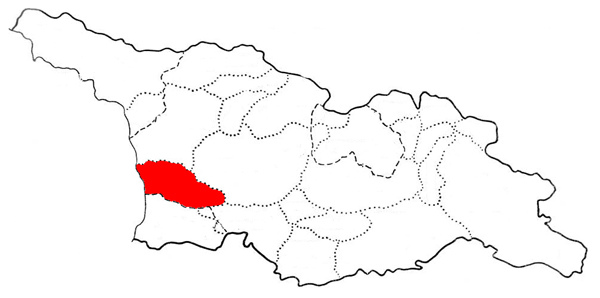- Principality of Guria
Infobox Former Country
native_name=გურიის სამთავრო
conventional_long_name= Principality of Guria
common_name = Guria
continent=Europe
status=Client state
empire=Kingdom of Imereti (1460s-1810),Imperial Russia (1810-1828)
status_text=AutonomousPrincipality
year_start=1460s
date_start=
event_start=Feudal wars in Georgia
year_end=1829
date_end= September 2
event_end=Annexation by Imperial Russia
title_leader=Prince-Gurieli 

government_type=Principality
common_languages=Georgian
religion=Georgian Orthodox
legislature=
stat_year=Present day Guria, Georgia
capital=Ozurgeti The Principality of Guria ( _ka. გურიის სამთავრო, "Guriis samtavro") was a historical state in Georgia. Centered on modern-dayGuria , a southwestern region in Georgia, it was located between theBlack Sea andLesser Caucasus , and was ruled by a succession of twenty-two princes of the House of Gurieli from the 1460s to 1829. The principality emerged during the process of fragmentation of a unified Kingdom of Georgia. Its boundaries fluctuated in the course of permanent conflicts with neighboring Georgian rulers andOttoman Empire , and the principality enjoyed various degrees of autonomy until being annexed byImperial Russia in 1829.Early history
Since the 13th century, Guria, one of the provinces of the Kingdom of Georgia, was administered by hereditary governors (
eristavi ) from theHouse of Vardanisdze to which the Georgian crown attached the title ofGurieli ("of Guria") c. 1362. In the 1460s, when the power of theBagrationi Dynasty of Georgia was on the decline, the Vardanisdze-Gurieli dynasty joined a rebellion of the great nobles of western Georgia, led by a royal kinsman, Bagrat, who refused to accept the authority of KingGeorge VIII of Georgia . In 1463, Bagrat and his allies met and defeated the king at theBattle of Chikhori . As a result, George VIII lost all the western provinces, and Bagrat was crowned king of Imereti, i.e., western Georgia. However, in return for their aid, the new monarch was obliged to create a vassal principality (samtavro) for each of his major allies, including the Gurieli family which became semi-independent rulers of Guria with their seat atOzurgeti Suny, Ronald Grigor (1994), "The Making of the Georgian Nation: 2nd edition", p. 45.Indiana University Press , ISBN 0253209153] In 1491,Giorgi I Gurieli (1483-1512) was recognized as a sovereign prince. From this time on, the Gurieli also invested localbishop s at Shemokmedi, Jumati, and Khinotsminda, nominally under the spiritual superintendence of the Georgian OrthodoxCatholicos of Abkhazia . The polities of western Georgia fought one another for supremacy, particularly the Gurieli of Guria andDadiani ofMingrelia . They forged a temporary alliance and organized, in January 1533, an ultimately disastrous expedition against the piratical tribe ofZygii in the north of Abkhazia. This setback enabled the king of Imereti to reassert his hegemony over Guria, but for a short time.Under the Ottoman Empire
From the mid-16th century, the princes of Guria enjoyed a
de facto independence from Imereti, but faced much more serious threat from its newly emerged southern neighbor, theOttoman Empire , which imposed, in the 1540s, a naval blockade of Guria and annexed its southern provinces ofAdjara , NorthernChaneti (latter-dayLazistan ), andMachakheli , which had earlier been acquired byRostom Gurieli (1534-64). The situation became even more precarious after the allied army of Georgian dynasts suffered a defeat at theBattle of Sokhoista .Mamia II Gurieli (1600-1625) managed to reconquer Adjara in 1609, but was eventually forced to renounce, on December 13, 1614, any claims to the region and pay annual tribute to theSublime Porte . The incessant feudal wars in western Georgia resulted in the decline of Guria, which eventually succumbed to the vassalage of the neighboring principality of Mingrelia. Yet, several princes of Guria, most notablyGiorgi III Gurieli (1669-84), andMamia III Gurieli (1689-1714), managed to occasionally attain to the crown of Mingrelia and even of Imereti. The princely vassals of the Gurieli included the houses ofGugunava ,Machutadze ,Maksimenishvili ,Nakashidze ,Tavdgiridze ,Shalikashvili ,Zedginidze , andEristavi-Shervashidze .During the early 18th century, Guria faced an increasing political and economic downfall due to the Ottoman encroachments as well as repeated occasions of civil strife. Attempts by the Gurian princes to enter into alliances with other Georgian rulers and Russia resulted in a series of Turkish punitive raids. By 1723, the Gurieli had lost
Batumi andChakvi to the Ottomans and the whole coastline of Guria had been garrisoned by the Turks. The Gurian support to the Russians during theRusso-Turkish War (1768–1774) caused a severe reaction from the Ottoman government.Kobuleti and the surrounding area were detached from Guria and subjected toIslamization , anapostasy being the surest way to escape slavery."Encyclopædia metropolitana; or, Universal dictionary of knowledge", ed. by E. Smedley, Hugh J. Rose and Henry J. Rose (1845), p. 532.] The rest of Christian population had to move to safer regions of Georgia. This, combined with extensiveslave trade and Turkish inroads, resulted in a virtual depopulation of several areas of Guria towards the late 18th century. The population of Guria was estimated byGüldenstädt at 5,000, and by Reineggs at 6,000 families in the 1770s.Under Imperial Russia
The latter-day princes of Guria firmly chose a pro-Russian orientation. During the
Russo-Turkish War (1806–1812) , on June 19, 1810,Mamia V Gurieli (1803-26) accepted Russian suzerainty, receiving insignia of investiture from the Tsar.Lang, David M. (1957 ), "The Last Years of the Georgian Monarchy: 1658-1832", p. 52.New York :Columbia University Press ] Guria joined the empire as an autonomous principality, retaining its self-governance and a local code. Very desirous of adoptingEurope an customs and habits, Mamia initiated a series of reforms and modernized administration, economy, and education. He remained loyal to the Russian crown even in 1820, when his uncle, Kaikhosro, joined the rebellion in Imereti and Guria, which broke out spontaneously in protest to the Russian mistreatment of Georgian church and heavy taxation. [Ibid, p. 56] When Mamia died on October 26, 1826, his underage son, David succeeded him on the throne under the regency ofPrincess Dowager Sophia. Anxious to secure her autonomy from the Russian government, she sided with the Turks during theRusso-Turkish War (1828–1829) . On September 2, 1829, the Russian authorities deposed David and forced Sophia into exile to Turkey. Guria was annexed to the Russian Empire, first under a provisional governance, and then, in 1840, as the Ozurgetiuyezd within theKutais Governorate . [ge icon "გურიის სამთავრო" ("Principality of Guria"). In: ქართული საბჭოთა ენციკლოპედია ("Encyclopaedia Georgiana"). Vol. 3: p. 314-5. Tbilisi, 1978.]References
Wikimedia Foundation. 2010.
